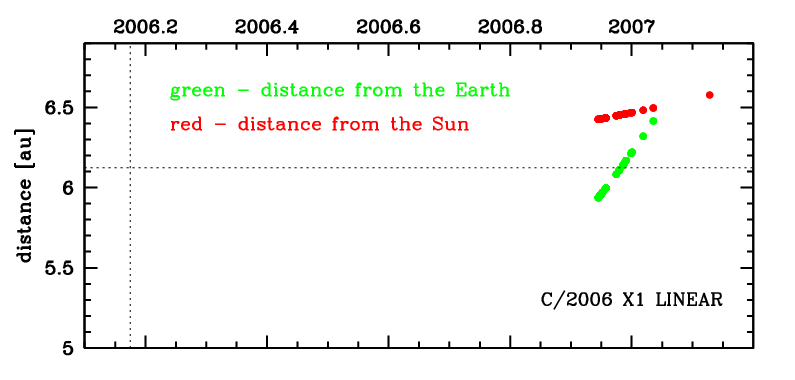C/2006 X1 LINEAR
more info
Comet C/2006 X1 was discovered nine months after perihelion passage and next observed 66 days (0.18 yr) in a narrow range of heliocentric distances from 6.43 au to 6.58 au.
Comet had its closest approaches to the Earth on 6 September 2005 (5.553 au. 7 months before perihelion passage) and on 12 October 2006 (5.535 au, two months before discovery).
This comet suffers small planetary perturbations during its passage through the planetary system; however, they could lead to escape of the comet from the solar system on hiperbolic orbit (see future barycentric orbit).
See also Królikowska and Dybczyński 2017.
Comet had its closest approaches to the Earth on 6 September 2005 (5.553 au. 7 months before perihelion passage) and on 12 October 2006 (5.535 au, two months before discovery).
This comet suffers small planetary perturbations during its passage through the planetary system; however, they could lead to escape of the comet from the solar system on hiperbolic orbit (see future barycentric orbit).
See also Królikowska and Dybczyński 2017.
| solution description | ||
|---|---|---|
| number of observations | 96 | |
| data interval | 2006 12 11 – 2007 02 15 | |
| data type | observed only after perihelion (POST) | |
| data arc selection | entire data set (STD) | |
| range of heliocentric distances | 6.43 au – 6.58au | |
| detectability of NG effects in the comet's motion | NG effects not determinable | |
| type of model of motion | GR - gravitational orbit | |
| data weighting | YES | |
| number of residuals | 185 | |
| RMS [arcseconds] | 0.39 | |
| orbit quality class | 2b | |
| orbital elements (heliocentric ecliptic J2000) | ||
|---|---|---|
| Epoch | 2006 12 11 | |
| perihelion date | 2006 03 05.64280635 | ± 0.36220668 |
| perihelion distance [au] | 6.12558539 | ± 0.00108144 |
| eccentricity | 0.99939905 | ± 0.00025141 |
| argument of perihelion [°] | 101.275279 | ± 0.037106 |
| ascending node [°] | 255.247320 | ± 0.004037 |
| inclination [°] | 42.615407 | ± 0.001975 |
| reciprocal semi-major axis [10-6 au-1] | 98.10 | ± 41.06 |
